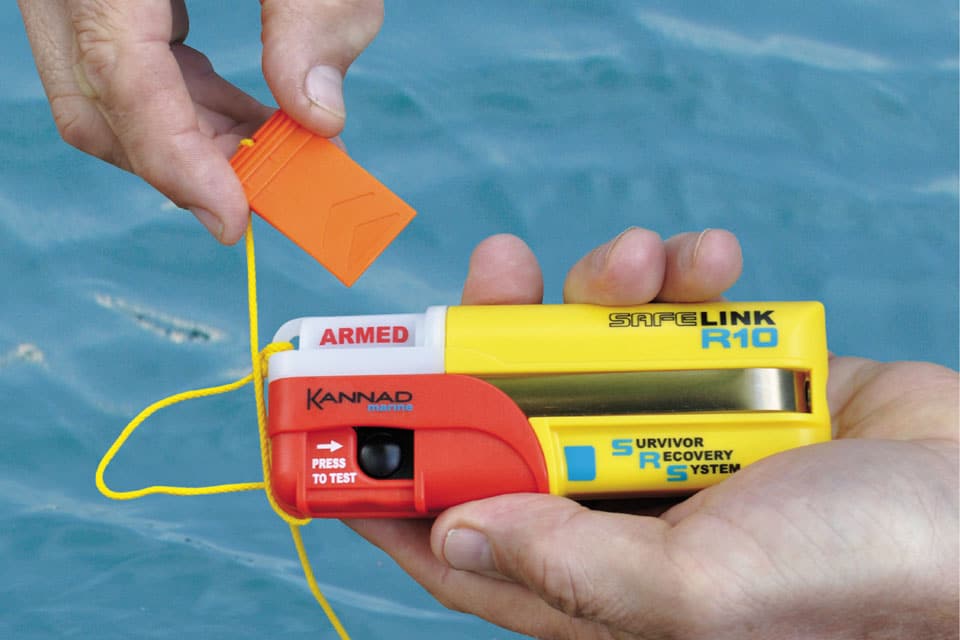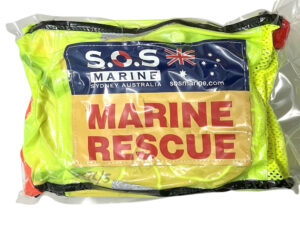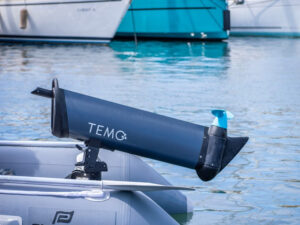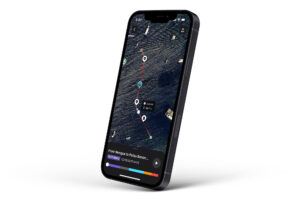
SafeLink R10 PLB
By now, I think we’re all pretty convinced that Emergency Position-Indicating Radio Beacons, better known as EPIRBs, are a good thing. If things go badly aboard your boat, activating an EPIRB will bring help fairly quickly, no matter where in the world you’re located.
As the technology has evolved, the components, and hence the devices themselves, have become smaller—so much so that today, quite capable EPIRB-like systems now come in compact packages that can be carried in pockets or attached to clothing or life vests. In 2003, after a prolonged federal permitting process, the United States approved these small devices for personal use, and personal locater beacons have became another option for safety-minded sailors.
Unlike EPIRBs, PLBs don’t necessarily float, can’t be automatically activated, and are only required to transmit for 24 continuous hours (instead of 48 hours) at temperatures of minus 40 F. Of course, if you’re in distress in warmer waters, both a PLB and an EPIRB will likely transmit for a longer period of time. Besides the main 406-megahertz distress and location frequency, all PLBs and many EPIRBs include GPS for faster position reporting and also transmit on the 121.5-megahertz frequency, which is used for “last mile” homing in by many search-and-rescue providers.
It’s my personal opinion that anyone who spends time on the water in any area should own some type of device that, should you fall overboard, makes it easy for your own vessel or for SAR assets to rescue you. These gadgets are an inexpensive, easy-to-carry way of increasing your odds of survival if you fall overboard or if your boat’s primary EPIRB malfunctions or doesn’t make it into your life raft.
There are also other personal-recovery products that don’t incorporate EPIRB technology but make particular sense for the recovery of men or women who fall overboard. Examples include the new Automatic Identification System crew-overboard beacons that alert your own and nearby vessels equipped with an AIS plotter and also various systems that use the 121.5-megahertz homing frequency or VHF channels to help the crew aboard the vessel quickly locate and recover sailors in the water without help from outside agencies.
The U.S. Coast Guard Navigation Center already references future EPIRBs that will incorporate AIS homing abilities, and I believe that we’ll eventually see PLBs that also combine these technologies. These units will allow a vessel that loses a crewmember to actively participate in the search, which could result in a far more timely rescue.
In the meantime, excellent PLBs and AIS COB beacons are commercially available now; some of these are new models, some are older but no less viable.
ACR has the largest selection of PLBs on the market today, with its latest offerings being the ResQLink and ResQLink Plus. Both units are small, with the ResQLink weighing in at 4.6 ounces and measuring 3.9 by 1.9 by 1.3 inches. The Plus version weighs in at 4.9 ounces and is 4.5 by 1.9 by 1.6 inches. Both units have a 66-channel GPS, blade antennas, and continuous strobes. They also incorporate self-test systems for both the GPS and the 406-megahertz transmitters and the ability to do some through-satellite testing without seriously denting the claimed 30-hour battery life. The only difference between the two is that the Plus model floats. These units have retail prices starting at $325.
ACR also offers the AquaLink and the AquaLink View, both slightly larger units. One difference between them is that the View’s little screen displays such reassuring info as position, battery life, and confirmation that the unit is transmitting. The other is that the AquaLinks have enough battery—35 hours’ worth—so they can use ACR’s 406Link.com through-satellite testing service for a limited number of “We’re here and OK” messages. These devices start at about $220.
McMurdo’s latest personal device is the FastFind 210, which weighs in at 5.3 ounces and measures 1.3 by 1.9 by 4.0 inches. It has a 50-channel GPS, operates at temperatures down to minus 4 F, and has a flashing LCD light. The FastFind 220 adds a buoyancy pouch. The FastFind Max G is a larger PLB that boasts a 48-hour battery life. These units start at $220.
Kannad offers two 406-megahertz PLBs, the SafeLink Solo and the SafeLink Pro. The Solo, a palm-sized unit encased in rubber, comes with a flotation pouch. It’s waterproof to 10 meters, has a flashing LED light, and provides a minimum of 24 hours of active battery life at temperatures to minus 20 C. The Pro is a slightly larger unit that boasts a 48-hour battery life. Both the Solo and the Pro use both 406 and 121.5 frequencies and have 50-channel GPS reception. Prices start at $270.
The likelihood of carrying a personal locator beacon is directly proportionate to the size of the PLB; in other words, the more convenient it is to carry and use, the more likely you are to wear it. With that fact in mind, Ocean Signal has introduced the rescueME PLB, a tiny (the manufacturer says it’s 30-percent smaller than the next-smallest PLB) unit with a hefty (seven-year) battery life, an integrated GPS with 66-channel capability (for extremely rapid signal acquisition), and one-hand operation. Even after the 24-hour satellite transmit time, the rescueME will continue to assist rescuers because the PLB’s homing beacon and strobe light will continue to operate. The rescueMe is waterproof but doesn’t float. It comes with a detachable floating lanyard, but it’s really meant to be mounted on a PFD, attached via the included rubber mounting strap. Ocean Signal is awaiting final approval from the FCC before releasing the unit for sale in the United States, but it expects that to happen as soon as this spring. Retail pricing on the rescueME slides in line with the other offerings in that market at $250.
Two AIS COB beacons are currently available in the United States: Kannad’s R10 SRS AIS and McMurdo’s Smartfind S10. Both companies are owned by Orolia, with the former offering devices geared to the recreational sailor and the latter aimed at pros.
The Kannad unit is designed to be attached to a harness/life jacket and is manually activated by pulling a tab, then removing a red arming cap. If the R10 is professionally installed on a harness/life jacket, it can be automatically activated when the life jacket inflates. When the unit is activated, it transmits a distress signal, including the overboard sailor’s position, to all AIS-equipped vessels within, typically, a 4-mile range. The Safelink R10 can transmit a signal for 24 hours and has a flashing LED light and a self-test feature with a battery-use indicator. Prices for this device begin at about $300.
The McMurdo Smartfind S10 is a buoyant AIS personal beacon that has the same range as the Kannad, which is more of an indication that AIS operates via a dedicated digital VHF signal, and as we all know, VHF operates in a line-of-sight manner. The antenna is internally mounted, and expected battery life is 24 hours. Of note to divers looking for a personal AIS beacon, the S10 is waterproof to about 200 feet. Prices start around $320.
Also approved by the Federal Communications Commission is the German company Weatherdock’s EasyRescue personal AIS SART, which is very similar to an AIS COB beacon except that it was developed before the AIS COB title was fully approved. It’s not offered for sale by any U.S. retailers that we could find, but cruising sailors who visit the Caribbean can find it in some chandleries for the equivalent of about $425. The EasyRescue has a tremendous 96-hour battery life, weighs 7.1 ounces, and measures in at 4.9 by 2.6 by 1.1 inches. The company’s very small WamBlee OneMan AIS SART may also be available soon in the United States.
Sea Marshall, a brand recently acquired by Mobilarm, offers what it calls a Maritime Survivor Locating Device, which uses the digital selective calling features on VHF radios. This palm-sized, water-activated unit will send a distress signal on the dedicated DSC distress channel, VHF Channel 70. GPS coordinates for the person in the water will be transmitted to all DSC-equipped radios within range. The final part of the safety net is a synthesized voice transmission on Channel 16, alerting even older, non-DSC-enabled VHFs to the overboard situation. The Crewsafe V100 is configured with what the company calls a regional profile, with different features offered depending on where the unit will be used, subject to the regulatory requirements in place in different parts of the world.
Mobilarm also has a more complex system aimed more at commercial users, the Mobilarm. Worn on a life jacket, the Mobilarm, when activated, transmits an alert on the partially phased-out 121.5-megahertz frequency to a base unit on board the parent vessel that monitors the 121.5-megahertz frequency and raises the alarm when it detects the emergency signal. The base unit indicates the direction and approximate range to the sailor in the water, enabling the crew to carry out the rescue.
Manufacturers
• ACR Electronics: www.acrelectronics.com
• Kannad Marine: www.kannadmarine.com/en
• McMurdo: www.mcmurdo.co.uk
• Mobilarm: www.mobilarm.com
• Ocean Signal: www.oceansignal.com
• Vesper Marine: www.vespermarine.com
• Weatherdock: www.easyais.de
CW contributor Tony Bessinger is a U.S. Coast Guard-licensed master and an instructor at Confident Captain/Ocean Pros in Newport, Rhode Island.








